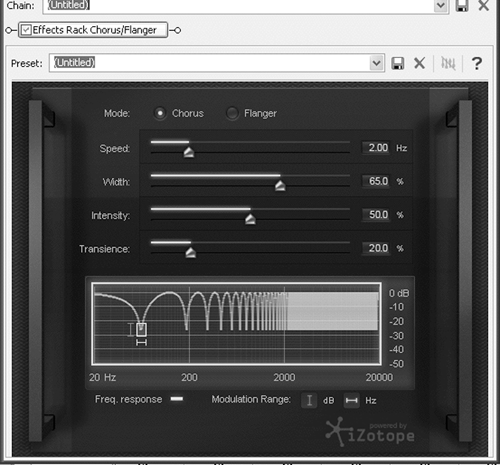
KILLER APP
For creating music promos and beat matching in general, Acid is still a killer app thanks to its adept implementation of time-stretch and -shrink audio files, and its ability to create seamless audio loops. These can be manipulated together or independently, making it easy, for example, to alter the tempo of a pop song slightly when matching it to other songs in a promo, or even to pitch-shift a VO read to get a specific effect. Audio loops can be stored in an ‘Acidized’ format which contains information about the original recording tempo, length (in beats) and root-note pitch. Like several other audio editors, Acid uses a resynthesis technique for time-stretching, which has markedly improved since Sony licensed Zplane’s elastique Pro software component. Zplane makes three versions of their algorithms available for licensing, and the Pro version in Acid 7 generates the highest quality results, according to the company. I was definitely able to apply more stretch before I heard glitches, in some cases well over 20%. The results are generally excellent, and although with any pitch-shifting or tempo-stretching the process only works within certain limits before audio artifacts appear, the new algorithms in Acid 7 allow a much more radical degree of stretch or shrink without artifacts than before.
The other key component of the Acid experience has always been the straightforward organization and ease of use of the interface. This makes the mixing and matching of loops so simple that, with the right combination of loops and music that’s somewhat close in tempo, even part-timers can use it to create very impressive results. The ability to preview Acidized loops in real time means that auditioning a new loop simply involves clicking on a file as you browse your loop collection in the Explorer window -- you’ll automatically hear it with its tempo and pitch mapped to those of the project.
The Media Manager goes a long way towards making those loops more accessible. It’s included with Acid 7 (and with Forge 9 and Vegas 8), but it is a separate install. Don’t ignore it -- it definitely speeds workflow. The Media Manager automatically scans your hard drives and finds audio bits, or you can manually add items. Once they’re in the Media Library, you can tag ‘em and bag ‘em, organizing them into folders with useful names (now there’s a concept!). As you do, the Media Manager builds a searchable database that works across all three Sony products, so if you’re a Vegas user your library may already be done. Of course if you buy any loops from Sony, they come to you pre-tagged for your dining pleasure.

EXTRAS
Sony bundles a whole lot of goodies with Acid 7. Unfortunately most of them are aimed at musicians -- there’s a Garritan sample playback plug, a guitar sample player from Native Instruments, and even a cut-down version of Submersible’s Drum Core plug-in. Fun if you’re into that, I suppose. But they do include four effects from iZotope (one of my favorite propeller-head DSP wizard companies) that are excellent.
I’m a big fan of authentic-sounding analog effects plugs, particularly Phasers and Flangers. The Flanger and Phaser included with Acid 7 are simply outstanding. The Flanger will also create a nice chorus effect, and can generate comb filters that are either gentle and sparse or deep and dense. The Phaser can be set to one stage for a gentle effect, or six stages for a deep swoosh, or anywhere in between. The Phase Difference slider lets you dial in the affected frequencies, and an EQ lets you tame the effect.
The Analog Delay plug has settings to emulate tape, or tape through tubes, or good old analog bucket brigade delay. There’s even a Trash setting to give you a little analog grit. The Dynamics plug has individual settings for compression, limiting, and expansion/gating, giving you the ability to set a multi-segment dynamics curve to handle just about anything. It sounds excellent, with no coloration... just lots of squash.

HELP PLEASE
The documentation included with Acid 7 is, frankly, a bit sparse. Whether you buy the download and get it as a PDF, or buy the boxed set and get a soft cover manual, it covers only the basics. However, Acid 7 comes with built-in interactive tutorials which are a help. I found that there’s a certain amount of trial and error involved in getting two dissimilar songs to play nicely together in a promo using Acid, and once I’d gone through the tutorials I felt mostly on my own.
Fortunately the learning curve gets flatter as I spent more time with the program. The fact that it’s organized much like Forge and Vegas certainly makes it easier, but if you’re going to create an entire music promo in Acid for the first time, you may want to take a dry run at it in private.
But once I established a workflow I was good to go, and it’s fun. The program’s ability to stretch and shrink music beyond recognition, almost without artifacts, is amazing. Now that it will record and edit audio just like Vegas, Acid has become a serious tool for any project that requires beat matching as part of the production process.
Acid has become a mature product for pros. If you’ve got an old copy of Acid Pro in any version tucked away on your hard drive, you should seriously consider the upgrade. It’s well worth it. Steve sez check it out.
Acid Pro 7 carries a US suggested retail price of $299.95 (download) or $314.95 (boxed). Upgrades from previous versions start at $134.95. A demo version is available, as is more information at www.sonycreativesoftware.com.
♦

